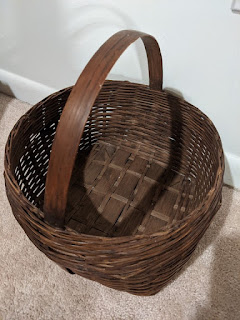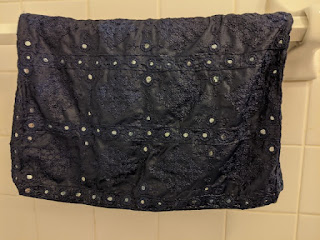The Idea
Weaving seems like a fun, low commitment, low pressure hobby. No deadlines, lots of potential yarns and fibers to experiment with. Let's build a frame loom! Even better, let's build a frame loom for almost free using scrapwood, some screws already on hand, and a box of wire brads that cost less than $2. Yeah.
The Creation
I had some easy-to-handle sized scrapwood pieces, so I laid them out on the floor to see how big my loom would be if I didn't make any cuts. I thought it might be nice to have a wider piece across the bottom, so I just went with these pieces as they were and decided to make a 'vertical' (portrait orientation) loom.
 |
| Loom pieces |
Not pictured in this post, but I happened to have a vat of indigo blue dye already on hand when building the loom, so I dipped the pieces in the dye bath just for funsies. After the wood had dried for a few days I gave it a coat or two of shellac (already on hand from another project) because I wanted a smooth surface to minimize any yarn snagging.
Next step was the placement of small brad nails to hold weaving warp. This stage is where I confirmed that I wanted to make a 'vertical' loom rather than a 'horizontal' loom. I laid out a piece of painters tape on each of the short pieces to make a straight edge and then measured 1 cm increments. I then nailed in each brad at the marked increment. I chose to use brad nails because they have a small head which seemed like it would make warping the loom, and later removing the warp, easier.
 |
| Tape measurements and nailed in warp supports |
Tip: Do not nail your nails through the painters tape, nail it NEXT to the painters tape edge. The small space between each nail can make removing any stuck tape a bit tedious. I think I used tweezers at some point because I couldn't fit my finger between the nails.
 |
| Brads nailed in place |
Once the brads were all in place I assembled the 4 loom pieces together, using two screws at each corner. If you only use one screw there is a possibility that the pieces could get 'out of square' with each other, and nobody wants a wonky loom.
 |
| Loom top with warp threads |
Conclusion
The loom is heavier than if I had used MDF or some sort of thin plywood, but as far as a scrapwood loom that cost $2 and some time it works juuust fine. Here it is with a test weaving showing that everything is holding together under the warp tension and (light) weight of the weft fibers.
 |
| Loom in action |
Happy freestyling, or bargain creating if that is where the wind takes you!

















